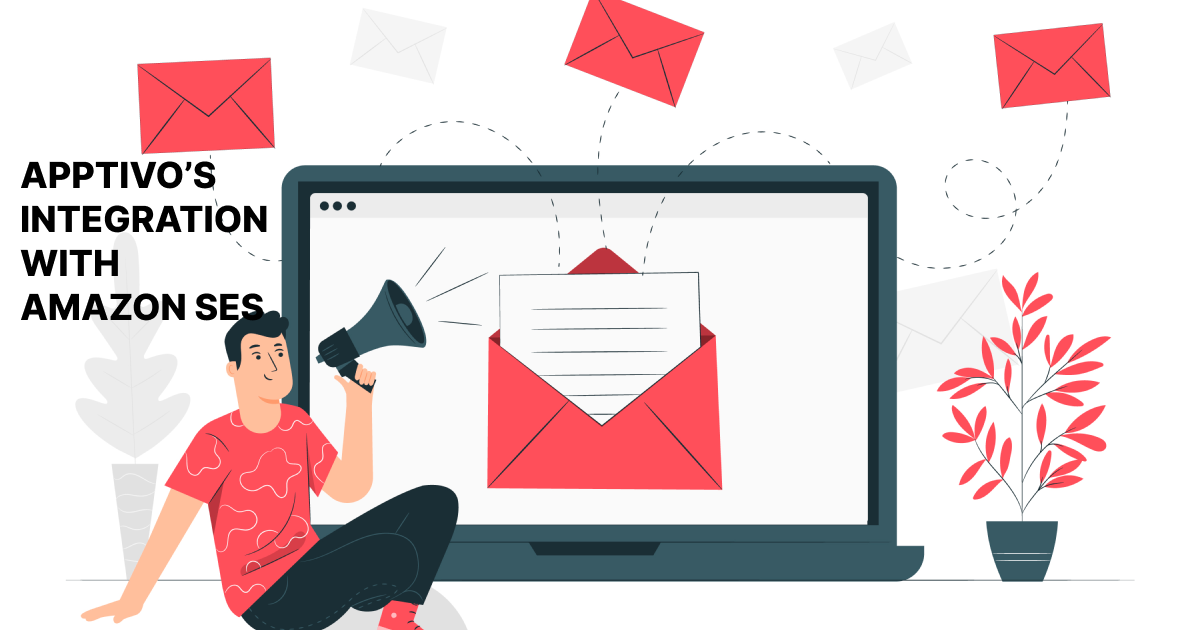 |
1. What is an email response management system (ERMS)?
2. Benefits of an Email Response Management System
3. Why does your business need an ERMS?
Communication is the lifeblood of a successful organization, and in the midst of an onslaught of emails, Email Response Management Systems (ERMS) shine as a light of efficiency. Handling the increasing volume of emails sent and received will be a headache without an ERMS in place. Let’s take a look at ERMS and see how it can help businesses overcome email congestion, improve response times, and cultivate unwavering customer happiness.
What is an email response management system (ERMS)?
An Email Response Management System (ERMS) is a useful tool for businesses to manage and organize their email communications. Its goal is to increase the value of email for both the business and its customers. Businesses can optimize their use of email as a medium of communication, both internally and internationally, by implementing an ERMS. This system enables a variety of functions such as email filtering, email activity analysis, email thread logging, and ensuring that essential actions are not ignored.
Implementing an ERMS enables team members to respond quickly, lowering the chance of getting swamped by unanswered emails. Furthermore, an ERMS provides significant insights into team performance and individual contributions to managers. These insights can be used to detect and address bottlenecks, resulting in greater overall efficiency.
 |
Benefits of an Email Response Management System
Here are a few important benefits of employing such a tool:
Enhanced productivity
ERMS automates email management duties like categorizing, sorting, prioritizing, and routing incoming messages. It aids in the automation of email workflows and lowers the time spent on manual processing, allowing users to focus on more important activities and increase overall productivity.
Faster response time
Canned replies or email templates, which allow users to construct predefined responses to common enquiries or commonly asked questions, are frequently included in Email Response Management Software. These templates can be customized to reply swiftly to customer inquiries, reduce response times, and improve customer satisfaction.
Performance analytics & reporting
Many ERMS have analytics and reporting features that enable customers to track and measure email response times, customer satisfaction levels, and other metrics. These insights can be useful in finding areas for improvement, optimizing workflows, and providing team members with data-driven feedback.
Integration with other systems
ERMS can work with other software systems such as customer relationship management (CRM) tools, help desk software, and project management platforms. This interface allows for easy data movement between systems, increased workflow efficiency, and a comprehensive view of consumer interactions.
Security and compliance
Email Response Management Tools frequently include strong security capabilities to safeguard sensitive information and ensure compliance with data privacy laws. They may incorporate encryption, access restrictions, and auditing tools to ensure the security and compliance of email communications.
Efficient email organization
Businesses can use an ERMS to automatically sort incoming emails into different categories or labels depending on data such as sender, subject, keywords, or programmed rules. This aids in the organization of your inbox and ensures that important messages are immediately accessible, minimizing the likelihood of missing critical information.
Collaboration and delegation
ERMS frequently include elements that encourage team member cooperation. Within the system, emails can be shared, assigned, or delegated to different team members, allowing numerous people to collaborate on the same email thread or assignment. This improves collaboration and streamlines team communication.
Why does your business need an ERMS?
Let’s take a customer support department in an e-commerce company. Every day, they receive hundreds of emails from customers, ranging from product inquiries and purchase concerns to returns and reimbursements. To efficiently manage this influx of emails and provide excellent customer service, the company implements an Email Response Management System (ERMS).
With an ERMS in place, incoming customer emails are automatically sorted, categorized, and assigned to the right support agents based on specified rules. Emails about order monitoring, for example, may be routed to agents who specialize in logistics, whilst product-related questions may be assigned to agents who have appropriate expertise.
In addition, the ERMS has a library of predetermined email templates and canned responses. This helps support employees to deliver standardized answers to frequently asked queries or address individual difficulties more rapidly. Agents, for example, can use a pre-written template that includes extensive instructions and the relevant forms when consumers inquire about the return process.
Furthermore, the ERMS monitors response times, workload distribution, and customer satisfaction indicators. This data enables the organization to monitor and analyze the performance of their support personnel. They can identify locations where response times can be reduced, manage resources more effectively, and assure consistent service quality.
Integration with the company’s CRM system expands ERMS’s possibilities even more. Customer contacts and email exchanges are automatically documented within the CRM, allowing agents to deliver personalized and efficient support by providing a complete view of the customer’s history.
Also, the ERMS guarantees that rules and record-keeping obligations are met. It automatically archives all incoming and outgoing emails, making them easy to find and keeping a detailed audit record of customer contacts. This enables the organization in meeting its legal obligations and in settling any potential problems.
Features of Email Management Response Systems
Now, let’s look at how to choose the best ERMS for individual needs.
Email organization tools
Just as a well-organized wardrobe can help businesses effortlessly find and manage clothes, an effective email management app serves as a trusted wardrobe assistant, enabling to keep the inbox tidy and under control. Just as individuals have their unique way of arranging their clothes, finding an email tool that offers the right organizational features tailored to their preferences is crucial.
Look for email management app features that are similar to the compartments and functionalities of a wardrobe. These may contain virtual “labels” or “tags” that serve as categorization tools, allowing organizations to properly organize and sort their emails, similar to how clothes are organized by type or occasion. Similarly, “folders” in their email app can be analogous to wardrobe drawers or shelves, providing dedicated storage locations for specific types of emails or chats.
Archiving settings in the email app are analogous to storing seasonal clothing. Similarly to how people store winter clothes in the summer, archiving emails helps businesses tidy their inboxes while keeping critical messages accessible for future reference.
Email flags and stars act as wardrobe hangers, allowing them to mark specific emails as important or prioritize them, much like hanging their favorite garments in convenient reach. The “snooze” button in the email app is analogous to temporarily storing an outfit for later use, allowing it to create reminders and bring important emails back to attention when one is ready to address them.
A smart email management system should also provide personalized email handling standards, similar to having tailored dress recommendations. These rules enable businesses to automate certain actions for receiving emails, such as sorting them into designated folders or labeling them, expediting the email organization process.
Just like having numerous wardrobes allows people to segregate different types of clothing, having multiple email accounts allows organizations to create discrete compartments for different email addresses. This feature also enables for the creation of disposable email addresses, which are similar to owning a collection of trendy items that can be swapped out when extra security or temporary use is required.
Customer profiles
It might be difficult to handle several conversations across different channels and time periods when dealing with a significant amount of emails. However, if a customer care employee answers to an email without knowing about the customer’s previous interactions, providing a personalized experience becomes challenging.
Consider a customer who has previously contacted a company about a defective product. They include specifics in their initial email, such as the purchase information and the nature of the problem. They later write another email with a follow-up question regarding the same product.
If the agent does not have access to the customer’s history and cannot refer to a previous interaction, they may ask for duplicate information or deliver the wrong solution. This not only consumes time but also annoys the consumer, who expects a seamless and personalized experience.
In contrast, using an email management platform that includes a customer profile, the agent can rapidly evaluate the customer’s previous interactions. They can comprehend the customer’s background, preferences, and special wants. Armed with this knowledge, the agent can efficiently address the issue, focusing on the specific situation at hand and ensuring the consumer receives a personalized and satisfied resolution.
Automated workflow
There is a substantial amount of repetitious work involved for customer service representatives, administrators, and supervisors dealing with email management at scale. As a result, it is critical to have an email management platform that has sophisticated and user-friendly workflow automation tools. These automation solutions allow teams to prioritize, route, and, in some situations, respond to incoming emails automatically.
For example, with an effective workflow automation tool, email management software may be configured to handle different sorts of emails in specific ways. One type of email, for example, can be directed to self-service content, allowing users to locate answers on their own. Another type of email can have pre-written scripted responses. By integrating these automated workflows, a significant strain is eased off the shoulders of the agents, allowing them to focus on more difficult questions.
A comprehensive email management application with workflow automation capabilities enables organizations to optimize their processes by automating repetitive tasks. This optimization decreases agents’ manual workload, allowing them to devote more time and effort on resolving complex customer issues. As a result, efficiency, productivity, and overall customer satisfaction improve.
Email collaboration tools
Effective customer queries require effective team cooperation. Basic email management software lacks the features needed for efficient cooperation among service agents. To ensure optimal teamwork, look for an email tool that includes complete collaboration capabilities such as shared inboxes and collision detection. These features enable teams to collaborate effectively, guaranteeing timely and suitable responses to client enquiries.
Shared inboxes, for example, enable many agents to view and manage emails collectively, providing a collaborative atmosphere in which team members may cooperate, assign work, and support one another. Collision detection capabilities notify agents when many team members are working on the same email, preventing duplication and increasing coordination.
Teams can improve transparency and resource allocation within the service operation by implementing these cooperation elements. This transparency eliminates work duplication, ensures everyone understands their particular roles, and aids in task prioritization.
Reporting
Traditional techniques of data analysis within a shared Gmail or Outlook mailbox might be time-consuming. Implementing the correct email management software, on the other hand, automates the process and gives significant business insights across all elements of an organization. For example, Digital marketing agencies can use the software to categorize emails, provide data on client queries, response times, and project updates, allowing them to deploy resources more effectively and streamline internal processes. This saves time and increases efficiency, resulting in better customer experiences and campaign success.
Footnotes
To successfully process and answer a huge volume of incoming emails, businesses benefit from adopting an email response management system (ERMS). ERMS automates operations like email routing, ticket creation, and answer production, allowing firms to provide timely and consistent customer care. ERMS guarantees that agents have quick access to pertinent information by integrating with knowledge bases. In essence, ERMS improves corporate customer happiness by streamlining email handling and decreasing response times.
Latest Blogs

Apptivo's Integration with Amazon SES for Outgoing Email Server
Amazon Simple Email Service (SES) is an email platform that provides an easy, cost-effective way to send and receive email using your email addresses and domains. Apptivo has migrated its email service to Amazon SES (Simple Email Service) to enhance the performance and reliability of our email services
Read more →
EXPLORING MULTI CHANNEL CUSTOMER SUPPORT SOFTWARE
1.What is customer service software? 2
Read more →
Maximize your business performance with seamless CRM Integration
1.What is CRM Integration? 2
Read more →
